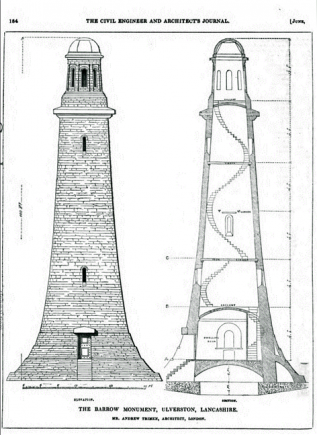Sir John Barrow Monument Ulverston
Sir John Barrow had been born at Dragley Beck Cottage near Ulverston in 1764. He travelled to China and to South Africa, became Secretary to the Admiralty in 1804, promoted expeditions to the Arctic, and died in 1848 at the age of 85. The Sea-Mark and Monument to his memory, built in the form of a lighthouse, was erected in 1850, the design being exhibited at the Royal Academy the following year. Sited on the 430 feet high summit of Hoad Hill, overlooking the town of Ulverston, the monument still commands extensive views across Morecambe Bay and the mountains of the Lake District and Pennines. The following description written by Trimen Andrewappeared in the Gentleman’s Magazine :
The plan of the tower is circular, with a spreading base, the general form being similar to that of the Eddystone; the lantern however in this case is of the same material as the general structure, and forms a consistent architectural feature. The structure is based on the solid limestone rock, of which the Hoad Hill is composed, and which was found immediately under the turf at the summit. The ring immediately above the surface is 150 feet in circuit, being wrought in stone, and forming a set‑off or base, two feet in width, from which the surrounding panorama, one of the most beautiful in England, may be contemplated in all directions. The. thickness of the wall, at the surface, is twelve feet sit inches, intersected with a dry chamber, five feet at the base. The wall diminishes in thickness from twelve feet six inches to two feet at the cornice, which is formed of massive wrought limestone. The whole of the lantern and dome is formed of the same material, being wrought within and without. The steps of the door, and window jambs, the several rings of set‑offs, are all in the durable wrought limestone of the neighbourhood. The general walling is in the same stone and hammered to a sufficiently correct form. The lime of the mortar is from the same material, and set so hard, that, as the whole is compactly built (every stone being completely bedded in the mortar, and every joint completely flushed or filled,) in a short time the walls, it is expected, will form one thickness, of a most strong and lasting character.Probably no stone and mortar with which we are acquainted is better calculated to resist all influences of weather than that of Furness, and this monument, we trust, bids fair to stand as lasting a record as any in the island of an event of the age.
The interior is approached from due south by a wide flight of steps, on the right of which will be observed the " First Stone," with its inscription:
ON THE 15TH MAY, A.D. 1850,
IN THK 13th YEAR OF THE REIGN OF
HER MOST GRACIOUS MAJESTY, QUEEN VICTORIA,
SIR GEORGE BARROW, BART.
AND JOHN BARROW, ESQ. F.R.S.
DEPOSITED THIS STONE TO RECORD THE
COMMENCEMENT OF THE
TESTIMONIAL TO THK LATE SIR JOHN BARROW, BART.
ANDREW TRIMEN, ARCHITECT.
Over the entrance door are cut in bold relief the words: IN HONOUR OF/ SIR JOHN BARROW, BART./ ERECTED A.D. 1850
The saloon, or principal floor, is elevated about seven feet from the summit of the hill, thus furnishing a basement beneath. This apartment is eighteen feet nine inches in diameter, having deeply recessed windows to the cardinal points, the view from each of which can be scarcely equalled, either for sublimity or variety of beauty. A stove and range are formed in the recess of the west window. Iron girders form the skeletons of the several floors, so that the whole may be fireproof. The lantern is gained by a solid flight of stone stairs, protected by an ornamental iron balustrade, cast on the spot from the valuable ore procured from the base of Hoad. The pattern is of the fifteenth century, each exhibiting the initials J. B. The visitor, while winding the surface of the interior of the cone, is cheered by an occasional peep from the several windows with which the sides ore pierced, and reminded of the reward of the beautiful prospect that awaits him at the summit. The interior of the lantern is nine feet four inches in diameter, and perforated with eight circular openings : the same number of pilasters support the entablature and dome ; around the interior are graven the words Soli Deo Gloria. A flag‑staff of due proportions is fixed from the lantern, from which the flag of the nation, (a line‑of‑battle ship's Union Jack, presented by the Lords of the Admiralty, as a mark of their respect to the memory of Sir John Barrow), wafted by his native mountain breezes, will announce to generations yet unborn that the day of the birth of true greatness excites a nation’s joy, while that of his death is felt with a nation's regret; and the tower beneath will, it is to be hoped, stand as a monument of the events of a life passed in the service of his country, and extending over every hemisphere, honoured and appreciated by all classes of his fellows.
Reference Gentleman’s Magazine Feb Vol XLIII Page 142-145 with illustration.
